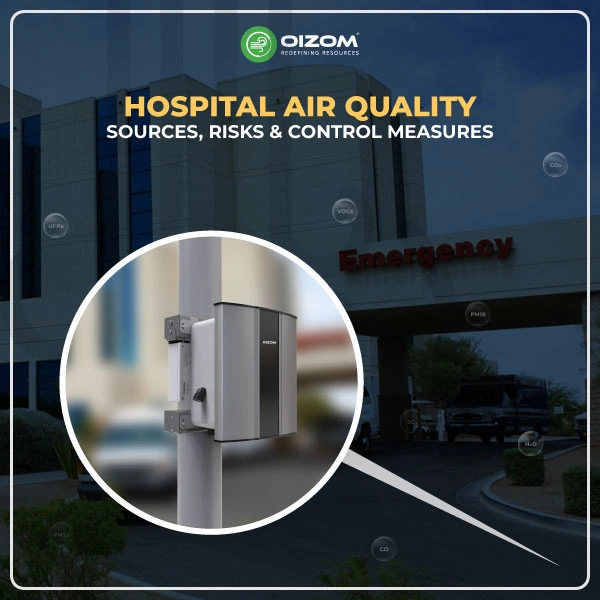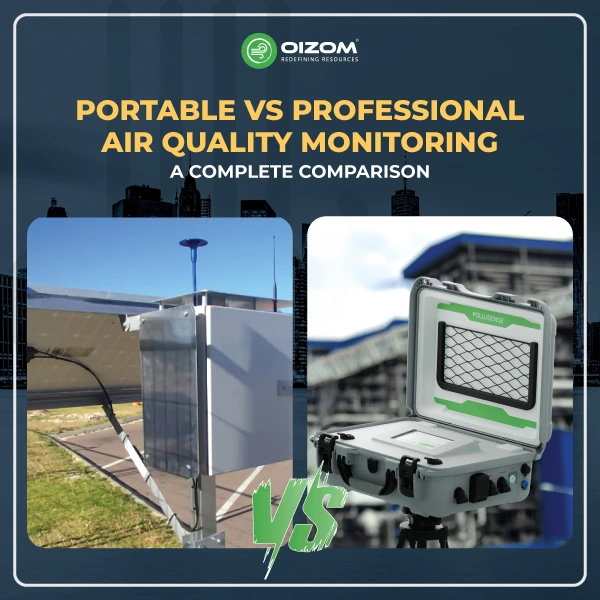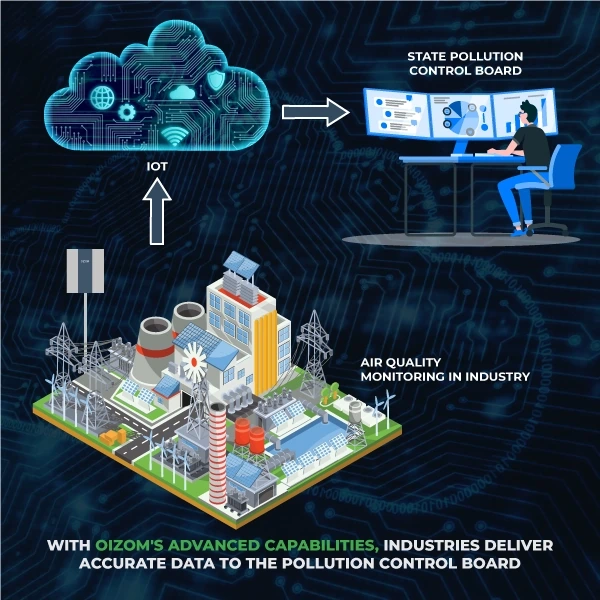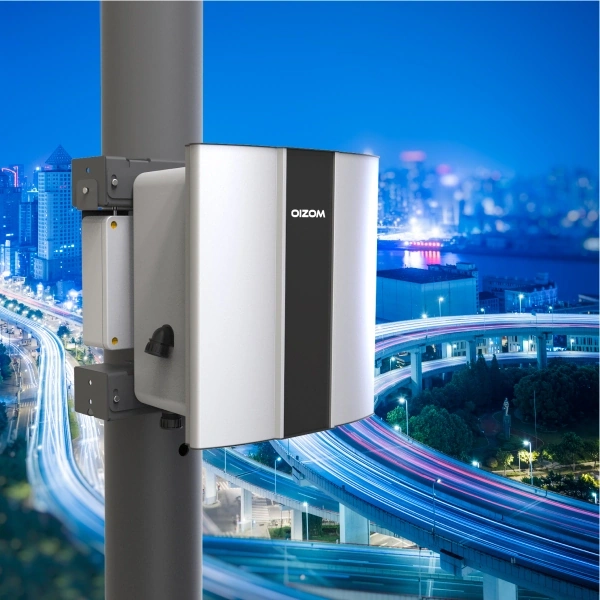Summary of Blog
Hospitals are meant for healing, but poor air quality can put patients and staff at risk. Inside, HVAC issues, surgical smoke, and disinfectants release harmful pollutants like VOCs, bioaerosols, and PM₂.₅. Outside, traffic fumes, industrial emissions, and construction dust make things worse.
Bad air quality isn’t just an inconvenience; it can lead to hospital-acquired infections (HAIs), slower patient recovery, and health issues for doctors and nurses. That’s why hospitals need proper ventilation, HEPA filters, and real-time air monitoring to keep the air clean.
Smart solutions like IoT-based sensors and AI-driven HVAC systems can track pollution levels and make instant adjustments to ensure safer indoor environments. Investing in air quality solutions like Oizom’s Odosense, an advanced odour monitoring system, helps detect VOCs like formaldehyde in real-time, ensuring hospitals can take timely action to maintain safe indoor air. It doesn’t just protect patients. It also reduces operational costs and improves staff well-being.
Hospital Air Quality: Sources, Risks & Control Measures
When we think of hospitals, we imagine a place of healing. But what if the air inside these facilities is doing more harm than good? Hospital air quality plays a crucial role in patient recovery, infection control, and healthcare worker safety. Yet, many hospitals unknowingly struggle with poor indoor and outdoor air quality within the campus. a silent threat filled with airborne pathogens, particulate matter, and chemical pollutants.
Inside hospital walls, HVAC inefficiencies, surgical smoke, disinfectant fumes, and bioaerosols contribute to indoor pollution, affecting lower air quality in wards, ICUs, and operating rooms. But the problem isn’t just inside. Traffic fumes, parking lot emissions, nearby construction, and backup generators release harmful pollutants like PM₂.₅, NO₂, and VOCs into the air, making it even harder to maintain a clean indoor environment. Hospitals near busy roads, factories, or landfills face even more significant challenges.
This article explores where hospital air pollution comes from, how it affects health, and the latest solutions, from HEPA filters and smart ventilation to real-time air quality monitoring. Let’s dive into how hospitals can achieve good air quality to ensure good health and can help protect patients and staff.
Why Hospital Air Quality Matters for Patients & Staff?
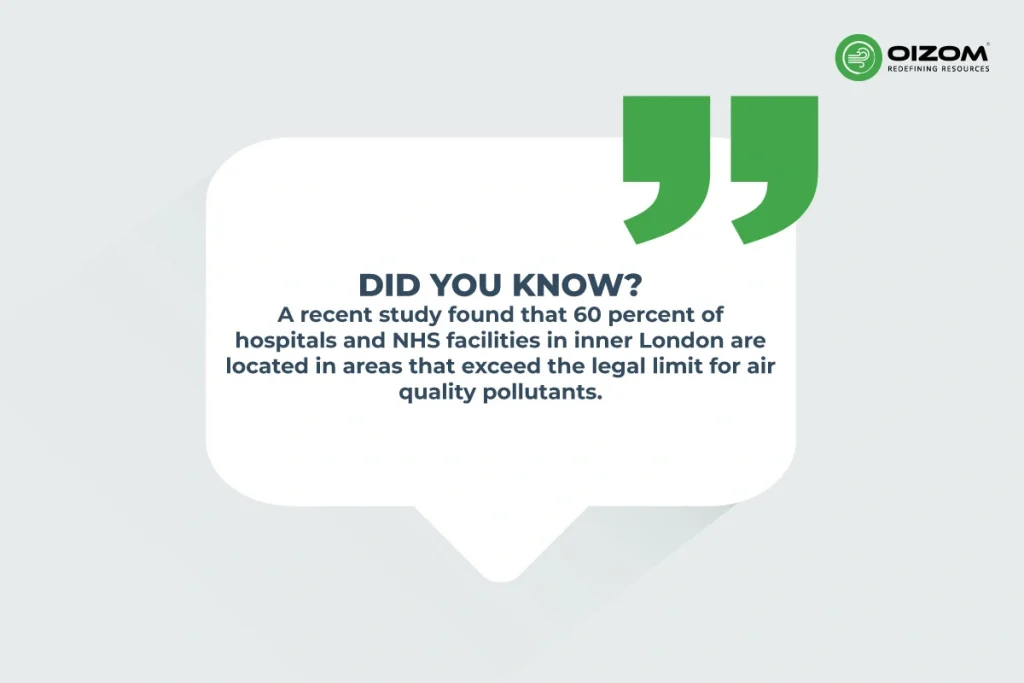
Did you know? A recent study found that 60 percent of hospitals and NHS facilities in inner London are located in areas that exceed the legal limit for air quality pollutants. Healthcare providers recognize the importance of clean air in hospitals. Good indoor air quality (IAQ) is essential for patient health, safety, and recovery, directly impacting infection control and overall well-being. Maintaining high IAQ ensures a healthier environment for patients and medical staff, improving safety and the overall hospital experience.
Poor indoor air quality (IAQ) increases the risk of hospital-acquired infections (HAIs) by allowing bacteria, fungi, and viruses to circulate, especially in ICUs, operating rooms, and isolation wards. For instance, airborne Aspergillus spores can cause severe infections in high-risk patients, particularly during construction or renovations. Poor ventilation and high PM₂.₅ levels can also slow recovery and trigger respiratory distress.
Hospital staff are constantly exposed to VOCs, disinfectant fumes, and fine particulate matter from cleaning agents and medical gases. Long-term exposure can cause respiratory issues, fatigue, headaches, and increased sick leave. High CO₂ levels due to poor ventilation can further impair alertness and decision-making, affecting patient care.
Hospitals must follow ASHRAE 170 ventilation standards, ensuring adequate air changes per hour (ACH) and filtration. The WHO and CDC recommend HEPA filters, negative pressure rooms for infection control, and real-time IAQ monitoring to maintain air safety.
The indoor pollutant levels can be up to five times, or even 100 times, higher than outside pollutant levels, giving rise to significant concern as the average person typically spends ~90% of their time indoors.
Key Sources of Hospital Air Pollution (Indoor & Outdoor)
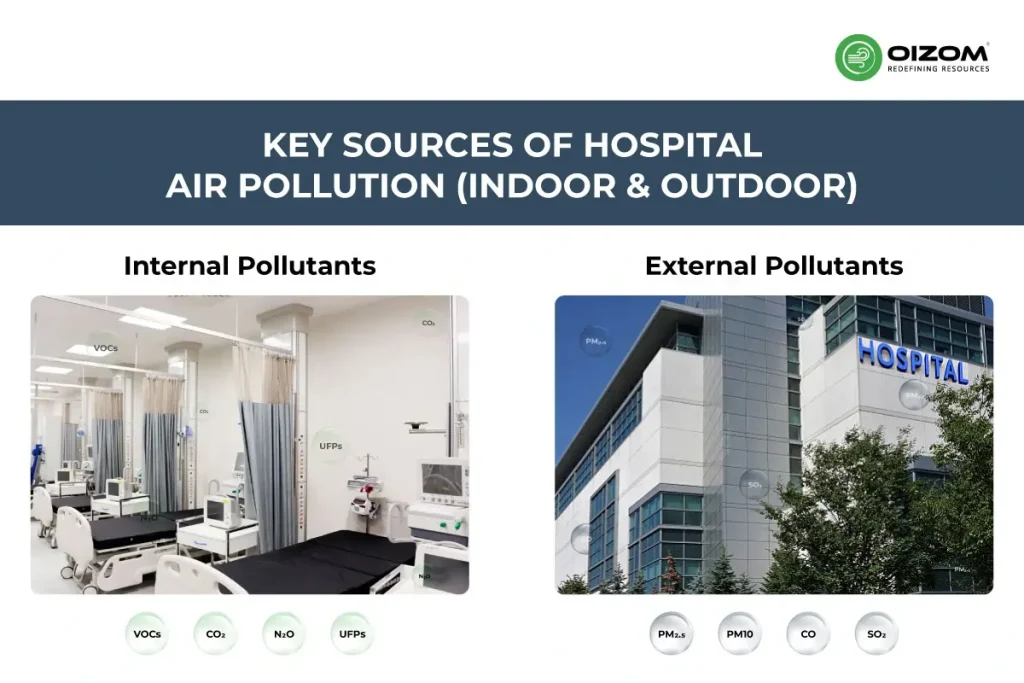
Hospitals face air pollution from both indoor and outdoor sources, affecting patient health and staff safety. Internally, poor HVAC systems can recirculate CO₂, VOCs, and bioaerosols, while anesthesia gases, surgical smoke, and sterilization chemicals contribute to airborne contaminants. Cleaning agents and disinfectants release VOCs, impacting indoor air quality. Building materials like paints, adhesives, and furniture off-gas harmful chemicals over time. Externally, pollution from traffic emissions, parking lots, nearby construction, and industrial zones infiltrates hospital spaces.
Internal Pollutants
Since people typically spend more than 90% of their time indoors, a fundamental element that affects their well-being and health is indoor air quality. Hospitals are complex environments where air pollution originates from multiple indoor sources, affecting both patients and healthcare workers. Understanding these sources is crucial for maintaining clean and safe air quality.
Indoor Air Pollutants in Hospitals
| Source | Primary Pollutants | Health Impact |
|---|---|---|
| HVAC & Ventilation Failures | CO₂, VOCs, Bioaerosols | Cognitive impairment increases HAI risk |
| Surgical Smoke | Ultrafine Particles (UFPs), Toxic Gases | Lung inflammation, occupational exposure |
| Cleaning Disinfectants | VOCs, Formaldehyde, Chlorine-based compounds | Respiratory irritation, skin reactions |
| Medical Equipment Off-Gassing | Anesthetic gases (Nitrous Oxide, Sevoflurane) | Endocrine disruption, ozone layer depletion |
| Indoor Mold & Bioaerosols | Aspergillus, Legionella, MRSA | Fungal infections, Legionnaires' disease |
HVAC & Ventilation Systems
Proper ventilation and air circulation are essential for maintaining indoor air quality (IAQ). Inefficient HVAC systems can trap and recirculate contaminants like CO₂, volatile organic compounds (VOCs), and bioaerosols instead of removing them. Poor ventilation also leads to higher humidity, creating ideal conditions for mold growth and bacterial spread.
HVAC systems are in charge of maintaining a high level of indoor air quality (IAQ) and a comfortable temperature for both employees and patients. The quality of the air in medical institutions is crucial. If the humidity, temperature, and air circulation are kept within the recommended range, the patients will feel more at ease and recover more quickly. For hospitals to remain open, their HVAC systems must be in working order. This is particularly true for spaces like operating rooms and clean rooms. To reduce the danger of infection for patients, air exchange, humidity, pressure, and temperature must be precisely controlled in these settings.
Did you know this? According to research by the Centers for Disease Control, one in 25 patients in the U.S. will suffer at least one infection acquired in the healthcare environment.
Medical Equipment & Procedures
Certain medical procedures contribute to airborne pollution in hospitals.
- Anesthesia gases (e.g., nitrous oxide, sevoflurane) can leak into the air, contributing to indoor pollution and occupational exposure risks.
Were you aware of this? A carbon footprinting study in three countries, Canada, the USA, and the UK, determined that anesthetic gas emissions can account for more than half of all emissions from surgical services.
- Surgical smoke from laser or electrocautery procedures contains ultrafine particles (UFPs), toxic chemicals, and cellular debris, which can be harmful when inhaled.
- Autoclaves and sterilization units release chemical byproducts that can degrade air quality if not properly vented.
Cleaning Agents & Disinfectants
Hospitals rely on strong disinfectants to prevent infections, but these can release high levels of VOCs into the air. Common sources include:
- Alcohol-based sanitizers
- Bleach and quaternary ammonium compounds (QACs)
- Floor cleaners and antiseptics
Prolonged exposure to these chemicals can irritate the respiratory system and contribute to indoor air toxicity.
Building Materials & Indoor Off-Gassing
Hospitals are built using various construction materials, furniture, and coatings, many of which release airborne pollutants over time. This process, known as off-gassing, affects indoor air quality (IAQ) and can pose health risks to patients, healthcare workers, and visitors.
1. Formaldehyde Emissions & Monitoring with Oizom Odosense
Formaldehyde is a toxic VOC commonly found in hospital furniture, flooring, insulation, and wall panels. It off-gasses into indoor air, leading to respiratory issues, eye irritation, and long-term health risks. Patients with asthma or compromised immunity are particularly vulnerable to its effects. Inadequate ventilation can cause formaldehyde concentrations to rise, increasing exposure risks.
To ensure safer hospital environments, monitoring formaldehyde levels is essential. Oizom Odosense, an E-nose-based Odour Monitoring System, is designed to detect formaldehyde emissions in real time, enabling hospitals to implement timely ventilation and filtration measures to maintain safe IAQ levels.
2. Lead and Heavy Metals
Older hospital buildings may contain lead-based paints, outdated plumbing, or contaminated fixtures, which can release lead and other heavy metals into the air. Chronic exposure to these pollutants is linked to neurological damage, respiratory diseases, and immune suppression.
3. VOCs from Paints, Adhesives & Coatings
Hospital renovations often involve paints, adhesives, and coatings that release VOCs, contributing to headaches, dizziness, and indoor toxicity. Prolonged exposure can impact both patients and healthcare staff.
VOCs can produce health effects by direct contact, primarily through skin contact as well as through inhalation. Diethyl phthalate and limonene exposure can lead to skin irritation, whereas 2-propanol may induce skin allergic reactions in some individuals.
Did you know this? A recent study revealed that 50% of the healthcare workers in operating theatres suffered from upper respiratory tract symptoms, 40% from skin reactions, and 25% from headaches.
External Pollutants Affecting Hospital Air Quality
Hospitals are not isolated from their surroundings; outdoor air pollution can infiltrate medical facilities, significantly impacting indoor air quality (IAQ). External pollutants enter hospitals through ventilation systems, doors, windows, and structural leaks, affecting patient recovery, infection control, and staff well-being. Without proper air filtration and monitoring, these pollutants pose serious health risks, particularly in ICUs, surgical rooms, and neonatal care units.
Want to dive deep into how real-time air quality monitoring can safeguard hospital environments? Check out our case study to learn how hospitals are leveraging data-driven insights to maintain clean, safe air because, in a place built for healing, every breath should be a safe one.
Traffic-Related Air Pollution (TRAP)
Hospitals located near highways, urban centers, and ambulance bays face high levels of traffic-related air pollution (TRAP), which consists of:
- Particulate Matter (PM₂.₅ & PM₁₀): Emitted from vehicle exhaust, brake wear, and road dust, these ultrafine particles can penetrate deep into the lungs, exacerbating respiratory illnesses in patients.
- Nitrogen Dioxide (NO₂): Released from fuel combustion, NO₂ irritates the airways, increasing the risk of asthma, bronchitis, and cardiovascular issues.
- Benzene & Volatile Organic Compounds (VOCs): Found in vehicle emissions, these carcinogens contribute to indoor air toxicity when they seep into hospital ventilation.
- Carbon Monoxide (CO): In hospitals with ambulance bays and underground parking, CO accumulation can lead to dizziness, headaches, and oxygen deprivation in enclosed areas.
Hospitals with underground parking lots or frequent ambulance movement are particularly vulnerable to carbon monoxide (CO) accumulation, leading to fatigue, headaches, and reduced cognitive function among hospital staff.
A study observed from monitoring stations in the Klang Valley, Malaysia, found higher levels of PM10, CO, NO2, and SO2 with the effects of traffic congestion.
Industrial & Power Plant Emissions
Hospitals near factories, power plants, and industrial zones experience higher exposure to:
- Sulfur Dioxide (SO₂): A byproduct of burning fossil fuels, SO₂ can trigger asthma attacks and lung inflammation when inhaled.
- Heavy Metals (Lead, Arsenic, Mercury): These toxic elements can enter the air from industrial waste disposal and coal-burning plants, posing neurological and respiratory risks.
- Persistent Organic Pollutants (POPs): Chemical byproducts from manufacturing processes can linger in the air and enter hospital ventilation, increasing health risks for long-term exposure.
Biological Contaminants
Hospitals also face outdoor biological pollutants that can compromise infection control and patient safety:
- Mold Spores & Pollen: These allergens enter hospitals through ventilation and worsen conditions for asthma and allergy-prone patients.
- Legionella Bacteria: Found in cooling towers and outdoor water sources, Legionella can become airborne and enter hospital HVAC systems, increasing the risk of Legionnaires’ disease.
Airborne Viruses & Bacteria: Pathogens from outdoor sources can spread through hospital air intakes, affecting immunocompromised patients and ICU wards.
Risks of Poor Air Quality in Hospitals
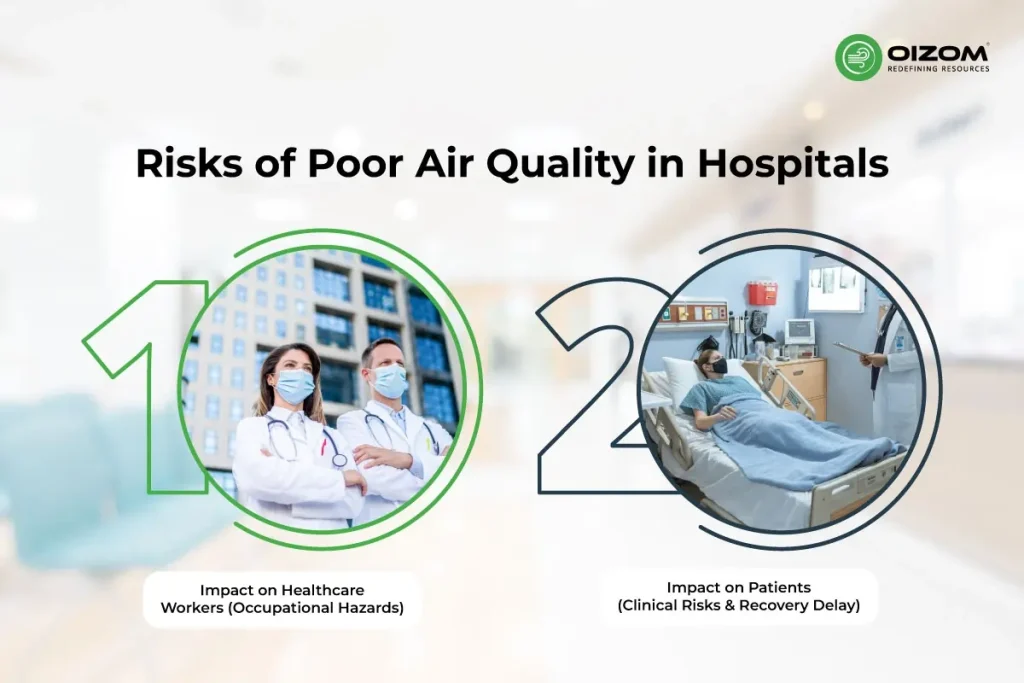
Poor air quality can worsen respiratory issues and put patients with weak immune systems at higher risk of infections and complications. Breathing in high levels of pollutants can also lead to serious health problems like heart disease and stroke.
Beyond health risks, air pollution can also affect hospital equipment. Medical devices and computer systems rely on clean air to function properly, but excessive pollutants can cause malfunctions or failures, disrupting hospital operations and potentially putting patients at risk.
Impact on Patients (Clinical Risks & Recovery Delay)
Hospital air quality influences patient health, infection control, and recovery rates. Contaminants such as airborne pathogens, particulate matter (PM), and volatile organic compounds (VOCs) can increase the risk of hospital-acquired infections (HAIs), respiratory distress, and delayed healing, especially for critically ill and immunocompromised patients. Did you know this? Air pollution was noted to have an excessive risk of 95% of total hospital admissions.
Airborne Infections & Hospital-Acquired Infections (HAIs)
Airborne pathogens like tuberculosis (TB), methicillin-resistant Staphylococcus aureus (MRSA), Aspergillus spores, influenza, and COVID-19 can spread through poor ventilation and recirculated air in hospitals.
- Aspergillus spores, commonly found in dust and construction debris, can cause severe fungal infections in transplant patients and those undergoing chemotherapy.
- MRSA and TB bacteria remain in the air and settle on surfaces, increasing cross-infection risks in ICUs and isolation wards.
- Viral pathogens, including influenza and COVID-19, can remain airborne for extended periods, affecting patients and healthcare workers.
Respiratory Distress in ICU & Immunocompromised Patients
Patients in ICUs, neonatal units, and cancer treatment centers are especially vulnerable to poor air quality.
- High levels of PM₂.₅ and NO₂ can worsen asthma, COPD, and lung infections, leading to more extended hospital stays and higher mortality risks.
- Immunocompromised patients are less able to fight airborne pollutants, making clean air essential for their recovery.
Delayed Wound Healing Due to Particulate Exposure
Studies show that exposure to PM₂.₅ and PM₁₀ can increase inflammation and slow tissue repair, leading to:
- Longer post-surgical recovery times
- Higher chances of infection in open wounds
- Complications in diabetic and burn patients
Impact on Healthcare Workers (Occupational Hazards)
Hospital staff are continuously exposed to airborne pollutants, making indoor air quality (IAQ) a critical occupational health concern. Poor IAQ can lead to respiratory issues, cognitive impairment, and increased absenteeism, ultimately affecting both healthcare efficiency and patient safety.
Increased Respiratory Diseases from Chemical Exposure
Healthcare workers frequently inhale volatile organic compounds (VOCs), disinfectant fumes, and fine particulate matter (PM₂.₅/PM₁₀) from cleaning agents, sterilization processes, and medical gases. Long-term exposure can cause or worsen asthma, chronic bronchitis, and lung inflammation, leading to higher respiratory illness rates among hospital staff.
Cognitive Decline & Fatigue Due to CO₂ Accumulation
High-density wards with poor ventilation often experience elevated CO₂ levels, which can impair cognitive function, reduce alertness, and slow reaction times. This poses a serious risk in critical care settings, where quick decision-making is essential for patient outcomes.
Increased Sick Leaves & Burnout from Indoor Air Toxins
Constant exposure to airborne pollutants and bioaerosols can lead to frequent headaches, fatigue, and respiratory infections, increasing sick leaves and workplace burnout.
Were you aware of this? New research suggests that polluted air in the UK causes 3m working days to be lost every year because people get sick or take time off to care for sick children.
Technical Strategies to Improve Hospital Air Quality
Maintaining high indoor air quality (IAQ) in hospitals is essential for infection control, patient recovery, and healthcare worker safety. Implementing technical solutions such as efficient ventilation, advanced filtration, IoT-based monitoring, and sustainable hospital designs can significantly reduce airborne contaminants.
High-Efficiency Ventilation & Air Exchange
Proper ventilation and airflow control ensure contaminants are continuously removed from hospital environments.
- ASHRAE 170 Compliance: This standard defines the minimum air changes per hour (ACH) required in ICUs, operating rooms, and isolation wards to maintain clean air.
- Negative Pressure Rooms: Essential for infection control, these rooms prevent airborne pathogens (e.g., TB, COVID-19) from escaping into other areas.
- Positive Pressure in Operating Rooms: Ensures sterile air is maintained by preventing external contaminants from entering surgical zones.
Advanced Air Filtration Technologies
Filtration is crucial for removing airborne pathogens, fine particulate matter (PM), and chemical pollutants.
- HEPA Filtration: Captures 99.97% of particles (≥0.3 microns), including bacteria and viruses, to improve hospital air quality.
- A study from Johns Hopkins Hospital demonstrated that HEPA filters in ICUs reduced airborne pathogens by 85%, leading to a 30% drop in hospital-acquired infections (HAIs).
- Carbon-Based Filters: Absorb VOCs and formaldehyde from cleaning agents, sterilization chemicals, and medical gases.
- UVGI (Ultraviolet Germicidal Irradiation): Used in HVAC ducts to deactivate airborne bacteria, fungi, and viruses.
IoT-Based Air Quality Monitoring in Hospitals
Real-time air quality monitoring enables data-driven decision-making to optimize IAQ.
- Smart Sensors: Detect PM₂.₅, CO₂, VOCs, humidity (RH), and airborne pathogens, providing instant alerts on pollution spikes.
- IoT-Driven HVAC Automation: Adjusts airflows, filtration efficiency, and ventilation rates based on real-time pollution levels.
- Hospitals can further enhance air quality management with Oizom Odosense, an E-nose-based odour monitoring system for real-time detection and mitigation. Relay-based automation in Oizom Odosense enables hospitals to automatically activate odour neutralizers or adjust HVAC systems when odour levels exceed set thresholds. This ensures immediate corrective action, reducing odour intensity and preventing contamination in waste disposal areas, ICUs, and pharmaceutical units.
Source Control & Green Hospital Initiatives
Sustainable hospital design minimizes indoor and outdoor air pollution risks.
- Low-VOC Materials & Antimicrobial Coatings: Reduce chemical emissions from paints, adhesives, and furnishings.
- Air-Sealed Hospital Design: Prevents external pollution ingress, ensuring cleaner indoor environments.
- Green Buffer Zones: Planting trees and vegetation helps filter PM₂.₅ and NO₂, improving air quality around hospitals.
Ensuring high air quality standards in hospitals is vital for patient care and regulatory compliance. Learn more with our use case on how air quality monitoring at hospital solutions help healthcare facilities maintain clean, safe indoor environments.
Cost vs. Benefit: ROI of IAQ Investments
Investing in air quality solutions brings long-term financial savings. Below is a comparison of upfront costs vs. annual financial benefits for key IAQ interventions:
| Intervention | Upfront Cost | Annual Savings / Benefits |
|---|---|---|
| HEPA Filtration in ICUs | $20,000 | 30% reduction in HAIs (~$300,000 savings annually) by reducing airborne pathogen exposure in critical care areas. |
| IoT-Based Air Quality Monitoring | $5,000 per ward | Prevents up to $100,000 in lost productivity by reducing respiratory-related absenteeism among healthcare workers. |
| Energy-Efficient HVAC with AI-Based Controls | $50,000 | $200,000 in reduced energy costs per year by optimizing air exchange rates and reducing unnecessary ventilation cycles. |
Conclusion
Clean air in hospitals is more than just a comfort factor. It is fundamental for patient recovery, infection control, and staff well-being. Poor indoor air quality (IAQ) can lead to hospital-acquired infections (HAIs), respiratory complications, and longer patient stays. With hospitals exposed to contaminants from medical procedures, cleaning agents, HVAC inefficiencies, and external pollution sources, ensuring safe air quality is a growing challenge.
The future of hospital air quality management lies in AI-driven purification and real-time monitoring. IoT-based air quality sensors now allow hospitals to continuously track PM₂.₅, VOCs, CO₂, and airborne pathogens, enabling proactive measures to maintain safe indoor environments. Automated HVAC systems can adjust airflows, filtration levels, and ventilation rates based on pollution trends, ensuring optimal air quality with minimal energy waste.
By integrating smart IAQ sensors and automated HVAC controls, hospitals can create a safer, healthier environment for patients, doctors, and staff. Similar to the stringent standards followed in Air Quality Monitoring in Pharma Industries, hospitals too must adopt precise and continuous monitoring strategies to safeguard both patients and healthcare workers.

